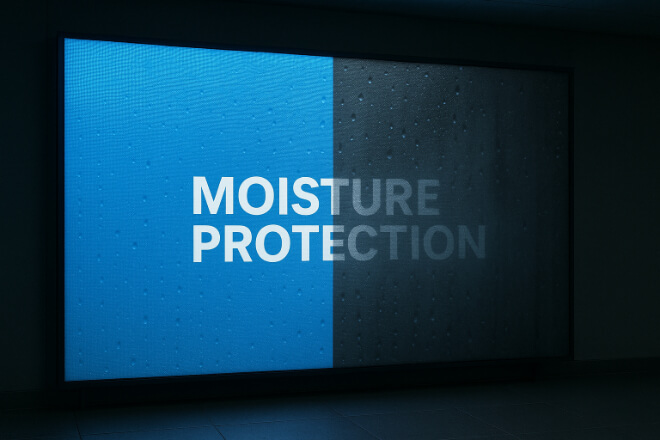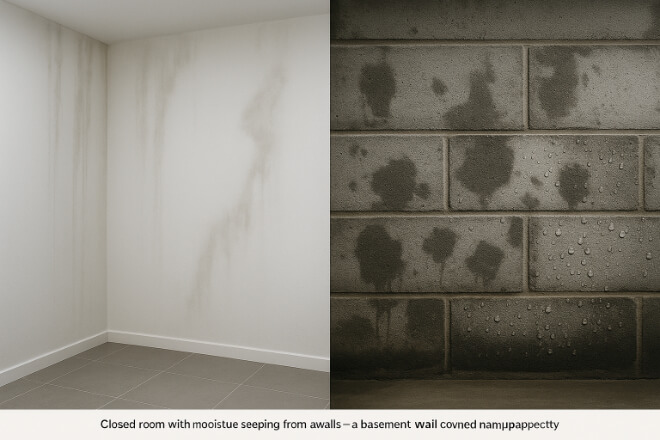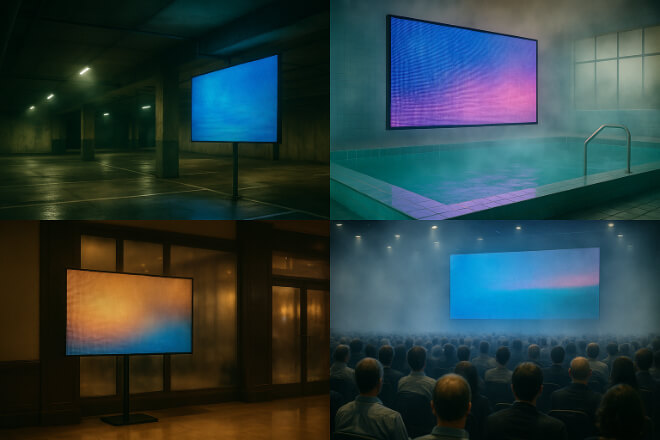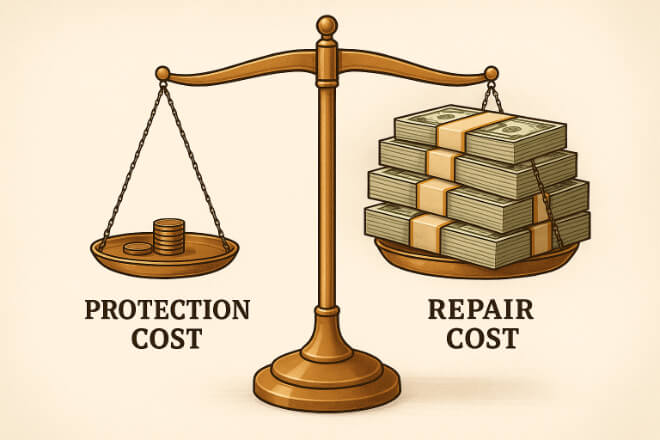Introduction

In humid environments, the lifespan and performance of electronic devices are often severely impacted. So, do écrans LED d'intérieur really need moisture protection?
Many people may believe indoor environments are relatively dry, so there’s no need to worry too much about humidity.
However, this isn’t the case. This article will delve into whether indoor LED screens need moisture protection and how to effectively prevent it, helping you better protect your devices.
Table des matières
1. Why can humidity occur "indoors"?

Many people think that humidity is a problem only outdoors, and that indoors should always be dry. This isn’t the case. Indoor humidity is more common than you might think.
Let’s start with climate. In tropical, subtropical, or coastal areas, the air itself carries a lot of moisture. Even with tightly closed doors and windows, moisture can slowly seep in.
People who live in these areas have likely experienced clothes hanging out to dry for days and still feeling damp.
Another example is underground spaces—basements, warehouses, and garages—which come into contact with the soil.
Moisture rises, making the floor sticky and the walls damp. Furthermore, some functional indoor environments are prone to moisture.
Poor air circulation in gyms allows sweat and steam to accumulate. Swimming pools and bathrooms, to name a few, are omnipresent.
Even air conditioning systems, if condensation isn’t properly managed, can add extra humidity to the room.
Additionally, newly renovated homes often harbor hidden moisture—if walls, floors, and paint haven’t fully dried, they gradually release moisture, unseen but accumulating.
So, don’t assume closing doors and windows will permanently eliminate the problem. Whether you live in Southeast Asia during the rainy season.
AEuropean coastal city, or a North American underground garage, indoor moisture can creep in.
The sources and manifestations vary, but the result is the same: the air becomes stuffy, making things susceptible to moisture and mold.
If care is not taken, electronic devices, furniture, and even personal comfort can be affected.
2. What are the dangers of humid environments to LED screens?

LED lamp beads appear sturdy, but they are actually very sensitive to moisture.
Once moisture seeps in, black spots may appear on the surface of the LEDs, causing a decrease in brightness or even complete loss of brightness.
The entire screen appears as if it’s been suddenly “patched,” with some areas dimming or even completely failing, significantly reducing the effectiveness of advertisements or information.
This problem is particularly common outdoors or in humid indoor environments, where it can easily develop unnoticed, often impacting the user experience by the time it’s discovered.
The core of an LED screen is the circuit board, but humidity can quietly corrode it. Prolonged exposure to moisture can cause solder joints to oxidize and components to rust, increasing the likelihood of short circuits.
The LED screen may flicker occasionally or completely fail, requiring disassembly for repair or component replacement. This process is not only troublesome but can also incur significant repair costs.
Moisture can make the image on an LED screen unpredictable. Colors may appear darker or yellower, the screen may flicker, or even be streaky, as if the previously delicate image has been disturbed by moisture.
This condition is particularly pronounced for screens used for advertising or displaying important information.
It can not only affect the visual experience but also make the content appear unprofessional and even create a negative impression.
Long-term exposure to humidity not only affects the LEDs and circuit boards, but also gradually degrades the screen structure, module connectors, and backplane screws.
An LED screen that could have lasted for many years may experience premature failure due to humidity, shortening its overall lifespan and effectively consuming its useful value prematurely.
Simply put, a humid environment is like “secretly accelerating the timer” on the screen, forcing it to “retire” early.
Beyond the LEDs and circuit boards, humidity can also affect the source de courant, cables, and control system.
Operation can become unstable, screen anomalies frequently occur, and maintenance frequency increases.
Over time, not only will the lifespan of the screen itself be shortened, but the user experience will also be significantly compromised, and the once smooth display will become unreliable.
3. Which indoor locations require particular attention to moisture prevention?

1) Underground Spaces
Although underground spaces may appear clean and tidy, they often lack adequate ventilation, allowing moisture to accumulate easily.
The floors and walls of underground centres commerciaux, subway stations, or parking lots can all be subject to chronic moisture.
If LED screens are directly exposed to such conditions, the luminosité of the LEDs may decrease, the colors may fade, and the circuit boards may corrode, effectively shortening their lifespan.
2) High-humidity locations
LED screens are most susceptible to moisture damage in locations with high humidity. Hot springs and spas are naturally steamy, pools are constantly emitting vapor, and cooking in the kitchen constantly generates heat and steam.
Long-term exposure to such conditions can cause screens to flicker, exhibit color deviations, and internal components to become damp or even malfunction, making advertisements and information appear strange.
3) Convergence of cold and warm airflow
Condensation easily forms when cold and hot air meet in certain areas, such as at the entrances to hôtel lobbies or warehouse doors.
Fluctuating temperatures can cause moisture to deposit on the screen surface or circuitry.
Over time, this “invisible moisture” can cause short circuits and accelerate equipment degradation.
4) Highly crowded but poorly ventilated spaces
Crowded areas can easily become humid. In multi-purpose halls, studios, or large conference rooms.
If ventilation is poor, moisture generated by breathing and movement will gradually accumulate, making the surrounding environment stuffy and humid.
LED screens in such environments may experience intermittent flickering and unstable colors, and internal components may age more quickly, making maintenance more difficult.
4. How can indoor LED screens effectively prevent moisture?

When selecting an LED screen, prioritize modules with three-proofing treatments. These modules are designed to withstand the effects of moisture, dust, and corrosion.
After installation, even slightly higher humidity levels will prevent damage to the LEDs and circuit boards, making the screen more durable overall.
It’s like putting a layer of “protective clothing” on electronic devices: more protection means less trouble.
If the indoor humidity is already high, control the air humidity with a dehumidifier, an air conditioner with a constant humidity function, or a constant temperature and humidity system.
Keeping the air within a certain range of humidity not only ensures the safety of the LED screen but also provides user comfort.
This type of equipment can effectively reduce moisture content in the air, especially in basements, near pools, or in crowded multi-purpose rooms.
The installation location of the LED screen is also crucial. Choose a well-ventilated location and avoid placing it directly where condensation is likely to drip or near exterior walls where water seeps.
Even if the environment is humid, good ventilation will allow moisture to dissipate quickly, reducing moisture damage to the screen.
Critical areas prone to moisture, such as interfaces, connectors, and alimentations, can be protected with moisture-resistant coatings or sealants.
This prevents moisture from penetrating the circuitry even when humidity rises, reducing the risk of short circuits and corrosion.
Simply put, it’s like adding a “waterproof door” to key areas, enhancing the screen’s safety.
5. Is there a need to budget extra for moisture-proof maintenance?

Many people worry about the high cost of moisture-proofing their LED screens. This isn’t a big deal. Protecting connectors with moisture-resistant coatings or sealants is recommended.
Or you can simply choose modules with triple-proofing treatments. These costs are actually quite low, but they can save you from potentially high repair costs in the future.
In the long run, these protective measures act like “insurance” for your screen, not only reducing wear and tear but also extending its lifespan and ensuring device stability.
Before installation, consult the manufacturer about moisture-proofing solutions and construction details to ensure the screen operates safely even in humid environments.
In addition, incorporating humidity checks into routine maintenance is essential. These simple checks can identify problems promptly, preventing minor moisture buildup from becoming major problems and keeping your LED screen in top condition.
6. Conclusion
After reading this article, do you have a clearer understanding of moisture-proofing for indoor LED screens?
Moisture-proofing is not only about extending the lifespan of the device, but also about ensuring stable operation and enhancing the user experience.
We hope these practical moisture-proofing methods will help you effectively cope with humid environments and keep your LED screen in top condition.
Finally, for more information about LED displays, please Contactez-nous.
